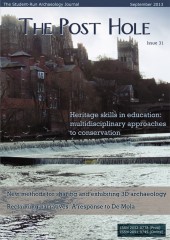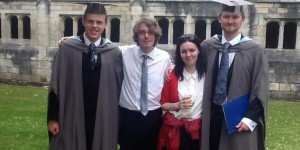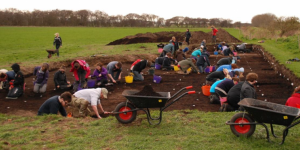“Western civilisation has moved towards an intellectually confused and thus morally disordered state” Paul Joseph De Mola writes in the last issue of The Post Hole (De Mola 2013), “we should pause and ask ourselves if it was reasonably the best course for society to undertake”. By this, De Mola means to single-handedly question the gains that archaeological theory has made over the past 20 to 30 years – the turn away from the pompous grand-narratives of the past, the assumptions of ‘truth’ and ‘progress’ that have been mostly discredited by post-processual doctrine, the very idea that there can be objective goals for well-ordered Western institutions to discover. De Mola (2013) demands a “correct structure” within archaeological theory that “cannot be arbitrary”.
I cannot agree more with De Mola’s intentions. His concluding remarks offer a serious challenge to the complacency of the postmodern trend within archaeology, and any fresh attempt to critique the malaise of the postmodern orthodoxy should always be welcomed. On the contrary, my problem with De Mola’s article is that it is not ambitious enough. The methods the author uses to explore postmodernism are insufficient, and loosely connected; De Mola’s own response to the philosophy is vague, verging on the uncritical; the scope of his argument is limited, and refuses to tie itself to the broader campaign of anti-postmodernism. I argue that while none of these factors render his conclusions useless, they do threaten to obscure them. While I intend this article to be read as a critique, it should also be read as complementary to the argument expressed by De Mola – a response rather than a riposte.
Vantages to vistas
The bulk of De Mola’s article is structured around three ‘vantage points’ which aim to flesh out the incursion of postmodernism into archaeology. The first of these is an economic discussion of the phenomenon of ‘McDonaldization’, or the centralisation of capital from small private companies to larger corporations. The second describes a concomitant process called ‘Corporatoxication’, a socio-economic bi-product of the first that is characterised by the depersonalisation of production and consumption. The third and final viewpoint is a little more removed from these arguments, and concerns the effects of postmodern dissemination strategy – the loss of central narratives and a growing trend of eclecticism within archaeological displays and heritage as a whole.
Yet it is not clear what advantage these vantage points enjoy over the debate. Given that the heritage and archaeological aspect of the article is limited discussion about displays and narratives, a general examination of postmodernist socio-economic narratives seems disproportionate. Nor is it clear why an economic view should be delineated from a socio-economic view, or how these relate to the debate about heritage displays.
Of all these vantage points, only the latter is considered critically. This is vexing, given that the lack of a counter-narrative to the postmodern line described in the first two sections risks presenting it as a legitimate, uncontroversial argument. This is an important clarification – either De Mola doesn’t agree with the narrative, or he does. If he doesn’t agree, he must explain how unsound postmodernist reasoning is on this issue, or risk ambivalence. If he does agree, then he has already conceded the most fundamental premise of postmodernism – that the centralisation of economic forces, cultural creativity and social activity are all the result of modernism.
The implication this has for archaeology is huge; what is the point of studying, practicing, teaching or simply disseminating archaeology if by doing so we are merely reinforcing a system that ultimately robs people of their trades and drains the colour from their lives? More specifically, how can we say that chronological displays are superior to thematic or eclectic displays in a world that is done with linear definitions of ‘progress’ and grand-narratives that provide context?
I find it important, therefore, to address this argument before even considering the archaeological debate. In his section on ‘corporatoxication’, De Mola eloquently sketches the generations-long process of telescopic capitalism, in which small private businesses get swallowed into larger and larger businesses until only multinational corporations exist. I do not disagree that this process occurs, but I distrust the postmodern explanation that this force within capitalist economy is linked to forces of modernisation (in contrast to Orser 1996); after all, it was a phenomenon identified most distinctly by early communists in the first half of the 19th century (for example, Engels 1845, 19-20).
In other words, to agree with the claim that Western economic climate promotes centralisation of capital does not necessarily tie one to the argument that this is ultimately because of ‘modernism’. For one thing, postmodernist historians and archaeologists are profoundly divided on what drives modernism, what modernism itself consists of, and how it can be traced through history (see Preece 2011, 15-16).
The argument that Western societies have moved into some sort of exalted ‘post-industrial’ condition seems distinctly undesirable this side of the recent credit crunch, and arguably, it under-estimates the fundamental industrial basis of supposedly transcendent countries like the United Kingdom (Preece 2011, 13-14). Meanwhile, as the diversity of postmodern viewpoints is commonly celebrated as a mark of intellectual freedom, this state of affairs is due ultimately because of the lack of consensus over what ‘postmodernity’ really means. Proponents have therefore tended to coalesce around a handful of popular characteristics; for example, the ‘post-industrial’ argument that underpins ‘McDonaldization’ and ‘corporatoxication’ (expressed first by Bell 1974, among others), and the reaction against grand perspectives or ‘metanarratives’ from both sides of the political spectrum (see Lyotard 1984; Hicks 2004, 135-171).
Archaeology and authority
It is this last characteristic of postmodernism – the collapse of principle – that holds the greatest relevance for archaeology. Discussing this in his third vantage point, De Mola rightly criticises the postmodern influence over archaeological displays through questioning the effectiveness of eclectic and narrative-destroying displays. He does this by building his point upon a case study of the Tempe Historical Museum, Arizona, before turning postmodernist logic against itself in an elegant twist (emphasis original):
“Postmodernity is a cultural condition that claims objectivity is a fallacy. If this is true, then the following question must be posited - from what objective premise are postmodernists drawing their (quite authoritarian!) conclusions regarding positivism?”
Yet he fails to recognise that this is only one symptom of the vast amount of disruption that belief in a ‘condition’ has generated; the problem is broader than just heritage displays. Archaeologists, students and heritage workers are now told to throw professionalism and objectivity in order to take their cues from popular culture and the demands of the market (for example, Shanks and McGuire 1996; Holtorf 2007) and give up the pursuit of becoming authorities in fields in order to facilitate pluralist debate (for example, Hodder 1999, 3-7); they are told that instead of making statements about the material world for others, they should retreat inside their own heads and concentrate on their personal bias (for example, Thomas 2001). Although these are stultifyingly poor stratagems that can never be adhered to wholesale within either archaeology or heritage, they nonetheless raise important issues academic debate should encompass.
In this respect, De Mola’s contribution to this debate demonstrates a refreshing willingness to engage in what has traditionally been a one-sided debate dominated by post-processualists. Explaining how his chosen display adopts the theme of water while abandoning all chronological context, he explains:
“does a canteen really have anything in common with an olla? Were the ideas, aspirations or interests of the miner the same as the Hohokam farmer? We understand their mutually shared environmental need for water.”
A further opportunity for critique presents itself; isn’t the theme of ‘water necessity’ a tributary of ‘environmental determinism’? This then presents a contradiction in aims, given that environmental explanations are thought to be too determinist, processual, modernist and positivist (Johnston 1998). Contradictions are not unprecedented; the Jorvik Viking Centre in York, for instance, has simultaneously been both praised and derided by post-processual critics for being populist and market-driven (Holtorf 2007, 24-25), and for being positivist and market-driven (Shanks and Tilley 1992, 86-88)! Such contradictions are the inevitable result of poor definition of beliefs and principles.
Aside from a commentary on this internal inconsistency, De Mola evades a larger argument about the principle of eclecticism. Eclecticism has, at its heart, the principle that everything is equally weighted in value, and in this sense can be closely identified with the post-processual commitment to pluralism. The problem is that this principle is based on unsound reasoning, and is totally impractical. For instance, the Hodderian conception of pluralistic archaeology entails “closer integration and mutual understanding” with groups as diverse as metal detectorists, ley line hunters, druids and creationists (Hodder 1999, 6-7), despite the substantial differences between these groups regarding their beliefs, internal dynamics and capacity to effectively interrogate the evidence of the past.
It is not for archaeologists to regulate the narratives of others, of course, but then archaeologists have never done so anyway; there is instead every reason for them to lend the weight of their authority on the more accurate and responsible groups. As yet, no post-processualist has been inclined to even consider the role of authority in relation to archaeology; archaeologists are supposed to facilitate the input and perspectives of others (for example, Moser et al. 2002).
Possibly this has gone ignored because of a curiously materialistic attitude among many post-processualists toward archaeologists – the notion that they are merely people who dig, and that the praxis of digging alone defines archaeologists rather than any especial quality of their views (see Yarrow 2006; Edgeworth 2011; Nilsson 2011). This view comports better with a pluralistic conception of public engagement strategies, as Meskell (2005, 85) has put it: “This is not to say our accounts are implicitly better [than others], but they are grounded in different ways”.
But there is every hope that this argument for authority, rather than plurality, is starting to gain traction in the archaeological community. Nowhere is this principle captured better than in Horning’s recent article, ‘Exerting Influence? Responsibility and the public role of archaeology in divided societies’ (Horning 2013), which explores the potential for archaeological authority to subvert a self-serving and politically polarised society.
Using the case study of Northern Irish archaeology and heritage, Horning describes how the post-1998 era has been dominated by a pluralist framework that reinforces differences between two dominant groups, Catholics and Protestants. Moving beyond this, Horning also notes how archaeology can be used to undermine commonly-held myths – such as that Scottish settlers came to a devastated land which they themselves developed, or that 17th century plantations ignored pre-existing Irish designs (Horning 2013, 24) – in a manner highly reminiscent of many Zionist narratives about Palestine before 20th century Jewish immigration (compare with Preece 2013). The reason to do so is quite clear; the vacuum left by professional ‘public intellectuals’ will always be occupied by less honest actors.
Subjects to objects
The final aspect of De Mola’s article I would like to develop is his tantalisingly brief view on postmodern relativism, or the belief that personal bias is insurmountable. This popular view has, in turn, led to a discipline that is “intellectually confused” and in a “morally disordered state”, which the author apparently regards as an unsatisfactory outcome.
It almost goes without saying that dis-order is a hallmark of the postmodern condition, and thus a goal for postmodernists; yet, if De Mola wanted to endorse a confident, authoritative, and indeed legible discipline, his methods are hardly best-suited to this task. He appears here to be out-flanking the postmodernists on their own terms, rather than suggesting credible ways to build archaeology and heritage around objectivity, authority and legibility. In this last section I wish to explore a new avenue of research that tackles the troubling subject-object split.
The issue of objectivity is central to the debate with postmodernists and post-processualists because the latter tend to believe that it does not exist; they argue that it is impossible for one to view the material world without personal prejudice. For example, Johnston (1998, 60) has argued that the notion of an external world is intrinsically linked to nationalist territorialism, and the postmodernist Zygmunt Bauman has claimed that objectivity – as a part of modernist scientism – was responsible for the Holocaust (Bauman 1989; Preece 2011, 15-16). This appalling claim that has been reiterated within archaeology explicitly by Thomas (2004, 49), and implicitly by Hodder (1998, 214): “After the horrors of the Great War, the Holocaust and Hiroshima, how can we put our faith in the mandate of Western reason?”.
There is an obvious counter to this argument; the very fact that there are such things as vehicular traffic, property boundaries and language demonstrates that we all share the same world and therefore perceptive differences from person to person exist firmly within real-world constraints. From this starting point a serious argument can only ever concern to what extent we can claim to represent material culture accurately – whether this means in context sheets, site reports, or heritage treatments.
On this level I am prepared to concede some ground to post-processual thinkers. For example, Yarrow has written of how the process of archaeology simultaneously objectifies archaeologists, by forcing them to work in structures, and subjectifies material culture, by turning it into artefacts, recognisable features, etc., thereby incorporating both poles of objectivity and subjectivity (Yarrow 2003). Chadwick has even devised new sets of context sheets designed to capture the recorder’s personal interpretation (Chadwick 2003, 108-9). Many post-processualists have also experimented with archaeological ethnography (for example, Moser et al. 2002; Yarrow 2006; Everill 2007) or the study of the social dynamics of excavation. While much of this work has ultimately been done in the interest of exploring subjective bias in archaeology, I am confident that it can be incorporated into the everyday structure of excavation – making it, for want of a more fitting term, processual.
It is the action of being ‘objectified’ that is significant to the argument against total subjectivity, because it illustrates our ability to be objective in our measuring of the real, external world. Archaeologists have long implemented several basic practices to ensure that they are not slaves to bias, such as working in teams so as to reach a shared opinion rather than a personal one and sharing their research in peer-reviewed journals.
All of these processes can be described succinctly as ‘accuracy’, which I believe is much more useful than ‘objectivity’ as a principle. Firstly, it neatly side-steps the subject-object split. Secondly, it captures the scale of objectivity much better than the term ‘objectivity’ itself does; objectivity and subjectivity are commonly held to be total, polarised opposites, whereas accuracy implies gradation. Thirdly, it works much better not as a principle to hold, but a principle to constantly aim for. This supports a framework for archaeology that challenges the nullifying relativism and tedious belief in total subjectivity that postmodern archaeology and heritage languishes in, and in that sense at least, I find them to be useful.
Conclusion – reclaiming narratives through principles
In this article I began by highlighting the significance of the postmodern socio-economic argument cited by De Mola, which I believe is crucial in underpinning all other narratives. An anti-postmodern response cannot afford to overlook this, and by merely exercising a certain amount of critical judgement we can justifiably present it as the product of assumptions and myths. It is not enough to merely suggest that postmodernist archaeology and heritage is benign; all myths and assumptions are damaging in some sense.
In this article I have chosen to illuminate the problems with eclecticism, pluralism and belief in total subjectivity, but there are indeed many more faults to pursue, including, though not limited to: the post-processualist conception of the archaeological record, phenomenology, democratisation of excavation, the emphasis on agency, and ecomuseum theory. Throughout I have tried to temper criticism with suggestions for improvement; it is easy to attack an argument, and much harder to offer anything in return. In this respect I have tended to build partially on the work of non-postmodernist post-processualists, and – regarding the concept of accuracy – have partially chosen to be speculative and abstract. These are options which anti-postmodernists may or may not explore, and at this stage require substantial development before they can operate as alternatives.
Finally, I wish to cross-examine a word that has appeared in the rest of this article frequently without being formally addressed – the notion of principle. I have intended to use this term fairly, with no implication that one side or another has a monopoly. Rather, I feel that principle has been neglected as a framing device by all theorists within archaeology, despite the fact that it is undoubtedly useful as a method of surveying the ultimate goals of postmodernists. In turn we must ask of ourselves what our own principles are, and what drives our separate or shared archaeologies. For good or ill, postmodernists have tended to selected eclecticism, pluralism and subjectivity. Whatever others may choose, I assert here a better trio: holisticism, authority and accuracy.
Bibliography
- Bauman, Z. (1989) Modernity and the Holocaust. Cambridge: Polity Press
- Bell, D. (1974) The Coming of Post-Industrial Society: A venture in social forecasting. London: Heinemann Educational
- Chadwick, A. (2003) ‘Post-processualism, professionalisation and archaeological methodologies: Towards reflective and radical practice’. Archaeological Dialogues. 10 (1). 97-117
- De Mola, P.J. (2013) ‘Capitalism, chaos and our postmodern society’. The Post Hole. 30. Available at: http://theposthole.org/read/article/211 [Accessed 29th July 2013]
- Edgeworth, M. (2011) ‘Excavation as a ground of archaeological knowledge’. Archaeological Dialogues. 18 (1). 44-46
- Engels, F. (1845) The Condition of the Working Class in England. Leipzig: Otto Wigand
- Everill, P. (2007) ‘A day in the life of a training excavation: Teaching archaeological fieldwork in the UK’. World Archaeology. 39 (4). 483-498
- Hicks, S.R.C. (2004) Explaining postmodernism: Skepticism and socialism from Rousseau to Foucault. Phoenix: Scholargy
- Hodder, I. (1998) ‘Whose rationality? A response to Fekri Hassan’. Antiquity. 72 (275). 213-217
- Hodder, I. (1999) The Archaeological Process: An Introduction. New York: Wiley
- Holtorf, C. (2007) Archaeology is a Brand! The Meaning of Archaeology in Contemporary Popular Culture. Oxford: Archaeopress
- Horning, A. (2013) ‘Exerting influence? Responsibility and the public role of archaeology in divided societies’. Archaeological Dialogues. 20 (1). 19-29
- Johnston, R. (1998) ‘Approaches to the perception of landscape’. Archaeological Dialogues. 5 (1). 54-68
- Lyotard, J.-F. (1984) The Postmodern Condition: A Report on Knowledge. Minneapolis: University of Minnesota Press
- Meskell, L. (2005) ‘Archaeological ethnography: Conversations around Kruger National Park’. Archaeologies. 1 (1). 81-100
- Moser, S., Glazier, D., Phillips, J.E., el Nemr, L.N., Mousa, M.S., Aiesh, R.N., Richardson, S., Conner, A. and Seymour, M. (2002) ‘Transforming archaeology through practice: Strategies for collaborative archaeology and the community archaeology project at Quseir, Egypt’. World Archaeology. 34 (2). 220-248
- Nilsson, B. (2011) ‘Archaeology and the unstoppable excavation machine: A Swedish point of view’. Archaeological Dialogues. 18 (1). 26-29
- Orser, C.E. (1996) A Historical Archaeology of the Modern World. London: Plenum Press
- Preece, J. (2011) Modernism and the Medieval: A critique of post-processual theories in archaeology and heritage. Unpublished MA dissertation consulted at the University of York, Department of Archaeology, The King’s Manor
- Preece, J. (2013) ‘Past political, present tense, future perfect? The concept of political intrinsicality in archaeology’. The Post Hole. 29. Available at: http://theposthole.org/read/article/206 [Accessed 2nd August 2013]
- Shanks, M. and McGuire, R.H. (1996) ‘The craft of archaeology’. American Antiquity. 61 (1). 75-88
- Shanks, M. and Tilley, C. (1992) Re-Constructing Archaeology: Theory and Practice. London: Routledge
- Thomas, J. (2001) ‘Archaeologies of Place and Landscape’, in I. Hodder (ed.) Archaeological Theory Today. Cambridge: Polity Press. 165-186
- Thomas, J. (2004) Archaeology and Modernity. London: Routledge
- Yarrow, T. (2003) ‘Artefactual persons: The relational capacities of persons and things in the practice of excavation’. Norwegian Archaeological Review. 36 (1). 65-73
- Yarrow, T. (2006) ‘Sites of Knowledge: Different Ways of Knowing an Archaeological Excavation’, in M. Edgeworth (ed.) Ethnographies of Archaeological Practice: Cultural Encounters, Material Transformations. Oxford: AltaMira Press. 20-32
- Witcomb, A. (2003) Re-imagining the Museum: Beyond the Mausoleum. London: Routledge








